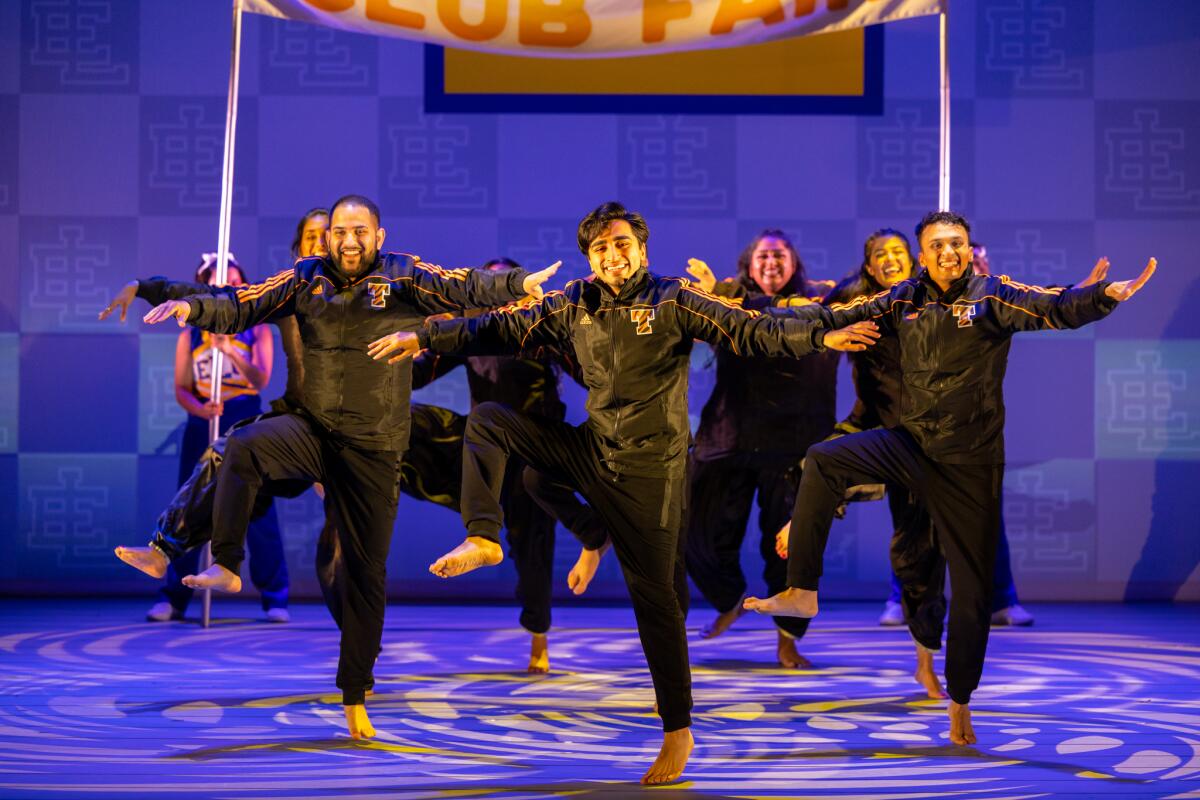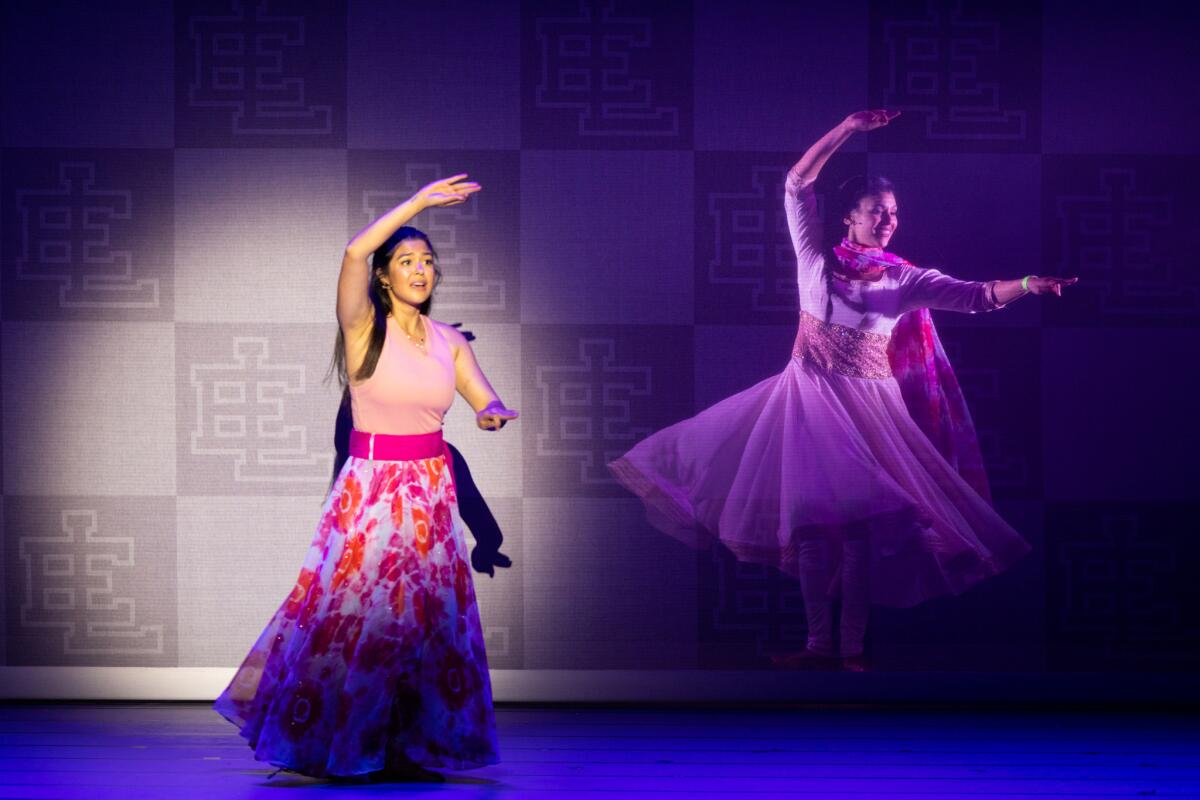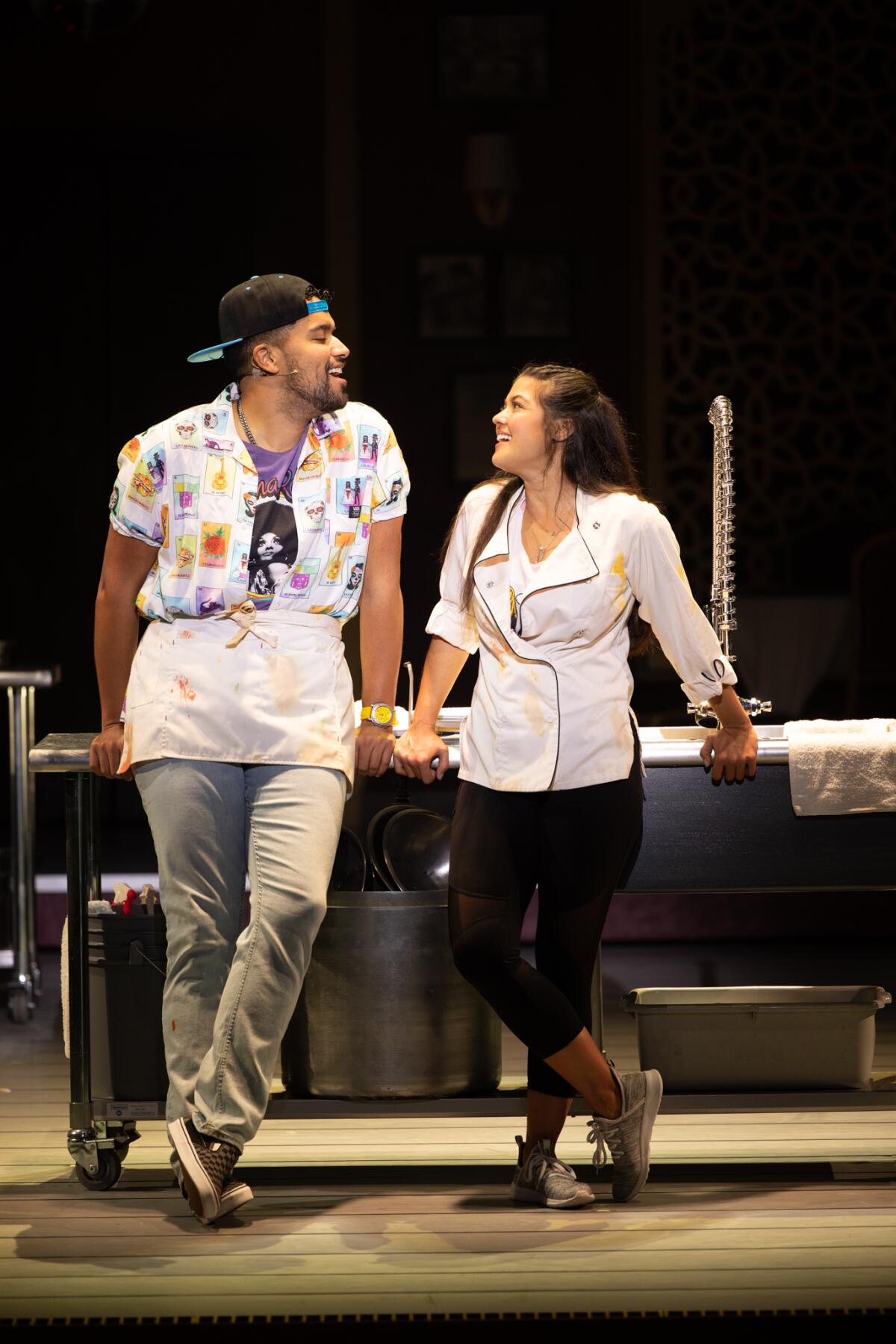The biggest entertainment stories
Get our big stories about Hollywood, film, television, music, arts, culture and more right in your inbox as soon as they publish.
You may occasionally receive promotional content from the Los Angeles Times.

In the montage-like opening of “Bhangin’ It,” a stage musical that showcases multiple styles of Indian dance and traditional Indian instruments, the energy and tensions are high. All the college students are smiling through the cardio-centric routines and collecting a trophy after each one. But one competitor, Mary, is visibly struggling, her teammates repeatedly vetoing her ideas.
“No,” she’s told, “because you’re diluting bhangra.”
Mary then responds with an audible force: “So, I’m not Indian enough for you? Is that it?”
That line echoes a question that multi-hyphenated Americans have asked themselves all their lives. Yet it’s one that’s rarely touched upon in contemporary-set musicals, let alone tackled with thoughtful nuance.
But “Bhangin’ It” manages to pull it off and more, without any kind of diluting. It presents multiple sides of complex discussions around cultural identity without declaring a definitive winner, incorporates deeply rooted South Asian art forms into an American musical without flattening pronunciations or practices for the historically white theatergoer and genuinely addresses these topics and conversations without sacrificing story, character or crowd-pleasing humor.
“We’re talking about pretty heavy topics through a really fun, bright and colorful musical, and that’s the type of storytelling that’s digestible and has the potential to be incredibly impactful,” says Ari Afsar, who plays Mary in the musical.
The pandemic’s collective pause over the last two years had many reconsidering their commitment to the theater industry. Here are 10 of their stories.
And after the pandemic’s collective pause and the industry’s reckoning with racism and abuses of power, “Bhangin’ It” is proof of the profound artistic achievements that yield from transformative justice techniques, which Afsar says “this creative team made a top priority.”

The world-premiere run of “Bhangin’ It,” now playing at La Jolla Playhouse through April 17, has been decades in the making. Playwright Rehana Lew Mirza first became enthralled with intercollegiate bhangra competitions back in 2003; she and fellow playwright Mike Lew frequented New York City’s Basement Bhangra on early dates and even performed a routine at their 2011 wedding.
“I fell in love with it because it’s this joyful and energetic dance style that’s so skilled but also incredibly welcoming,” says Mirza, who had drafted a screenplay on the scene. It wasn’t until composer Sam Willmott, with whom she and Lew collaborated at a 24 Hour Plays event in 2013, suggested the idea of a stage musical — an instinct that initially bristled Lew.
“In our plays, Rehana and I are constantly poking at: what is Asian American identity? What is it like to have multigenerational acculturation? And how do you hold on to your culture and form community around it to make sure it doesn’t die off, because not enough people adopt it?” he notes.
“I admit I had a preconceived bias about the [musical] form that came from not seeing enough of them, that they couldn’t contain the same kind of bruising politics that we’re able to pull off in our plays,” he continues. “I had thought that maybe all we can do in a musical is just have them dance bhangra and have a happy ending, and that didn’t feel like enough.”

Lew and Mirza committed to making “Bhangin’ It” a show that spoke volumes about cultural identity, and found collaborators who shared their vision. They wrote the book around Mary, a mixed-race college student who, after the initial altercation with her teammate, decides to form her own group on campus. But snafus with her new motley crew have her questioning the validity of her own experience, as she’s long considered her bhangra practice an affirmation of her desi identity and, even more so, a connection to her late Indian mother.
“No matter where you are, that struggle to figure out where it is that you feel you fit in is universal,” says director Stafford Arima. “But culturally, this story is very specific. I think we all feel a heightened intentionality and an acute awareness to really get it right.”
That attitude was adopted by every department of the production. Willmott wrote the music with renowned multi-instrumentalist Deep Singh, carefully calibrating their compositions to implement Eastern traditions and Western musical theater sensibilities.
“We’re not just putting songs to a bhangra beat, or playing the harmonium or the tabla just because,” says Singh. “There’s an understanding and execution of melodies from the culture, and we’re being sensitive to those sounds. Sometimes there’s something that’s off rhythm or a note that might be a little bit uncomfortable to the South Asian ear, so we move things here or there and we make it happen.”
Alongside his recorded performances of various instruments, Singh plays through each performance with the orchestra and steps onstage with the two-sided dhol Punjabi drum for multiple cast-wide dance numbers. (“Epsom salts are saving me — every other show, I’m in my bathtub,” he says with a laugh.)
The intimate play ‘Alma,’ about a Mexican immigrant mother and her first-generation American daughter, is playing at Culver City’s Kirk Douglas Theatre through April 3.

The score was specifically composed to showcase numerous Indian dance styles, from the upbeat bhangra competition sequences to a loving tribute to Bollywood. Most movingly, a lyricless duet, in which Mary performs a kathak routine alongside her late mother, echoes the dream ballets of Golden Age musicals.
It all concludes with a vibrant “megamix” finale. “These collegiate bhangra competitions have this way of feeling very interactive, and we wanted our audience to feel that too,” says choreographer Rujuta Vaidya. “By the end, they’re up on their feet, clapping along like they’re part of the show, and they leave the theater covered in confetti and dancing out of the aisles.”
The show’s commitment to authenticity was not limited to what was presented onstage. Behind the scenes, the production employed diversity, equity and inclusion consultants from Cornerstone Consulting to lead workshops with the cast, the majority of whom are performers of color.
“A lot of these actors are used to being the sole representative of their community in these rooms and having to do a lot of that cultural fluency work that’s outside their job description,” says Lew. “We needed a way to open the piece to this real wealth of lived experiences that everyone personally had, without anyone feeling like they had to fight for the right version of how to portray their culture.”

Those facilitated discussions — an example of transformative justice practices in theatermaking — led to “Toledo,” the musical’s radically insightful song about the prickly burden of representation: that expectation to be an expert of your own ethnicity, that pressure to overcome language barriers to communicate with family members, that feeling of internalized doubt within a community that ostensibly should be a source of comfort.
“The reality is, it’s hard to have these conversations in real life, let alone sing about it onstage,” says Afsar. “It’s teaching me a lot about myself and the shame I didn’t know I had. But there’s so much power in naming it, acknowledging it and sharing it with others, the way Mary and the other characters do in the story.
“Coming back to work after the shutdowns, there’s a different level of expectation of how we’re going to approach theatermaking differently, and this company took that very seriously, and that beautiful song is a direct result of that care,” Afsar continues. “I think we’re all still learning how to hold each other accountable with grace in order to do it in the best way we possibly can. But moving forward, I know this is the only way I want to work.”
‘Bhangin’ It: A Bangin’ New Musical’
Where: Mandell Weiss Theatre, La Jolla Playhouse, 2910 La Jolla Village Drive, La Jolla, CA 92037
When: 7:30 p.m. Tuesdays and Wednesdays, 8 p.m. Thursdays and Fridays, 2 and 8 p.m. Saturdays, and 2 and 7 p.m. Sundays. Ends April 17
Tickets: $25 to $87 (subject to change)
Contact: (858) 550-1010 or lajollaplayhouse.org
Running time: 2 hours, 30 minutes (one 15-minute intermission)
The biggest entertainment stories
Get our big stories about Hollywood, film, television, music, arts, culture and more right in your inbox as soon as they publish.
You may occasionally receive promotional content from the Los Angeles Times.